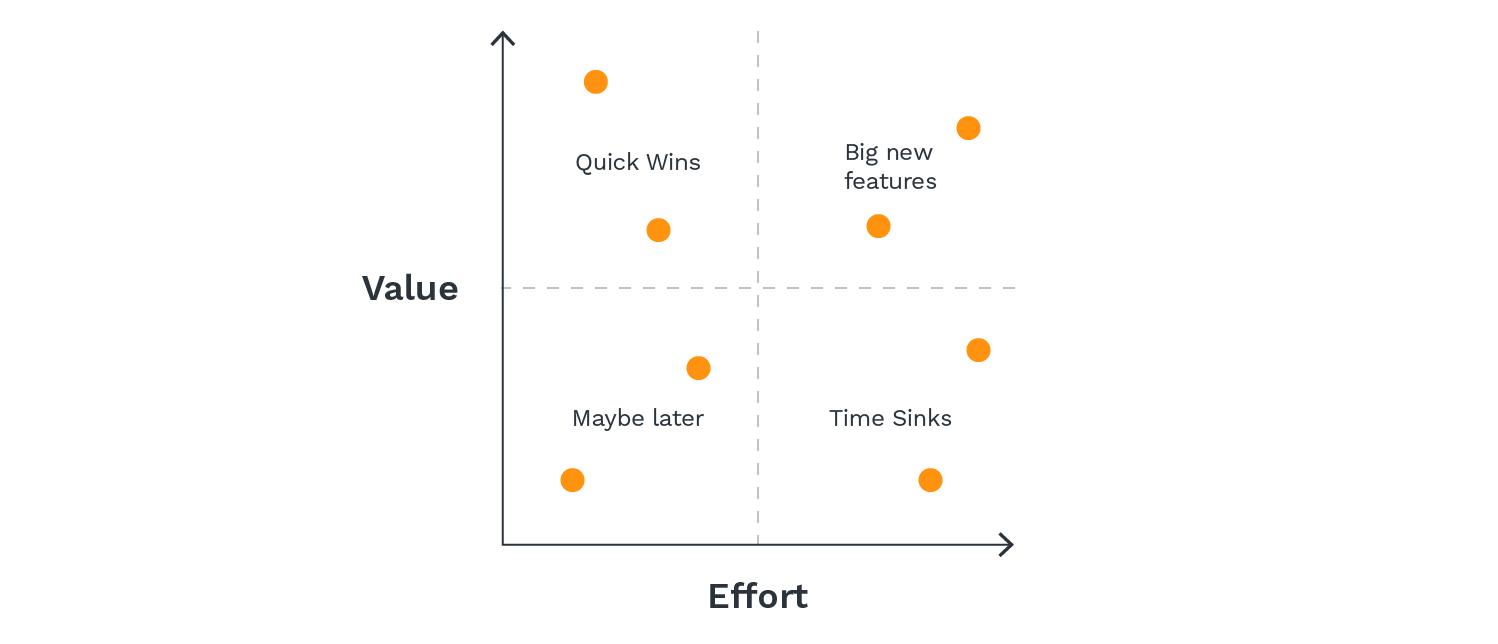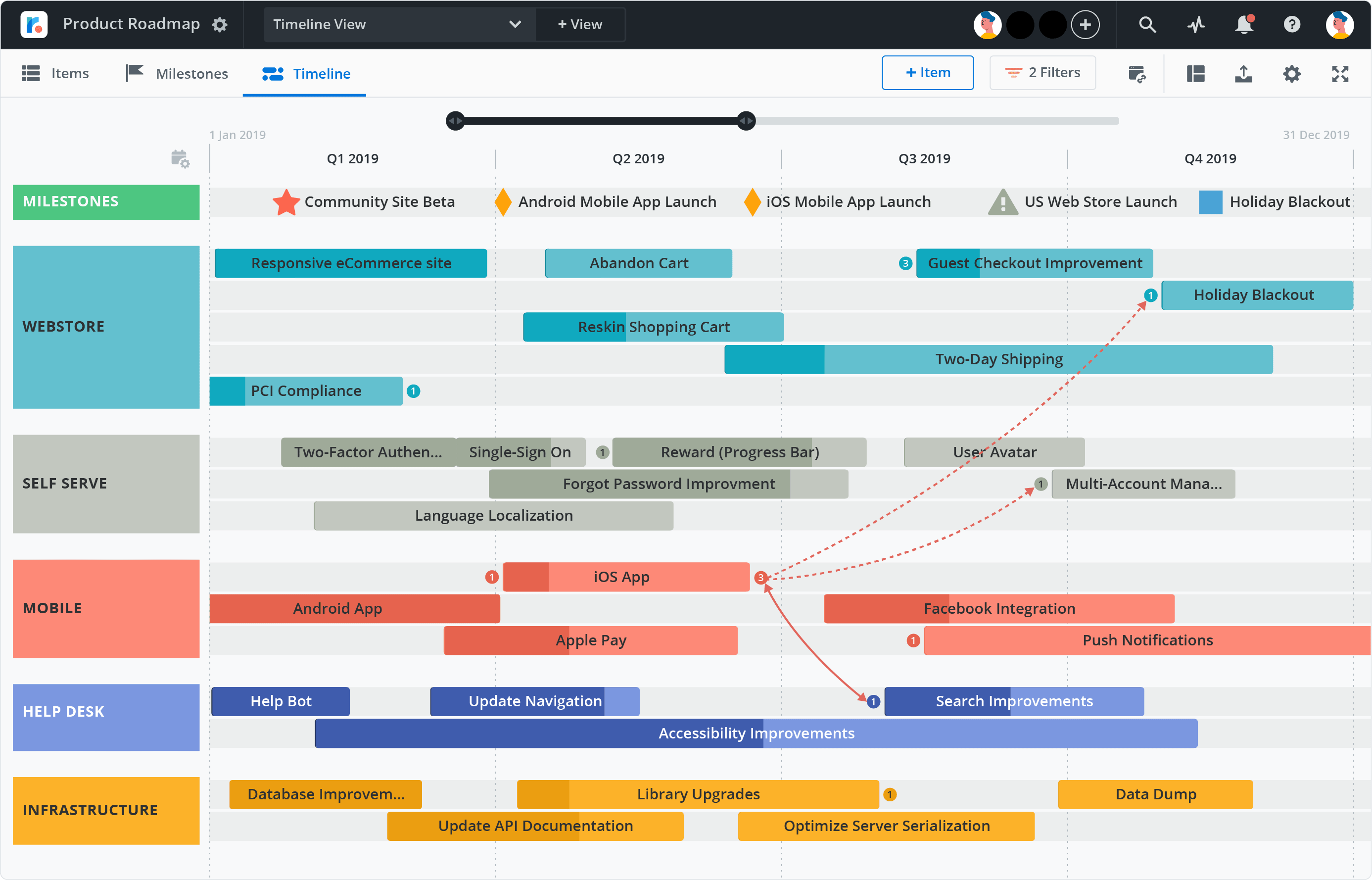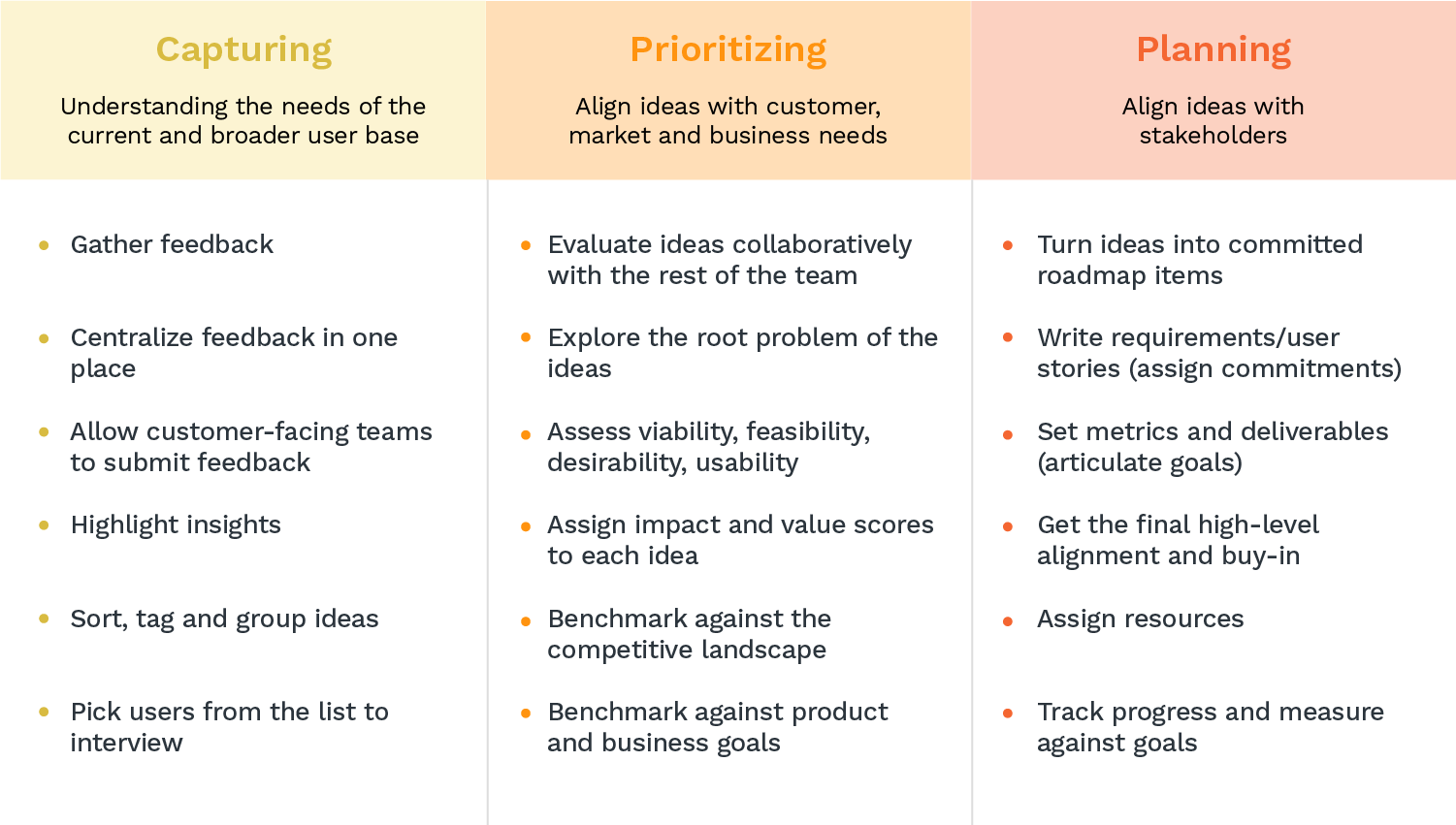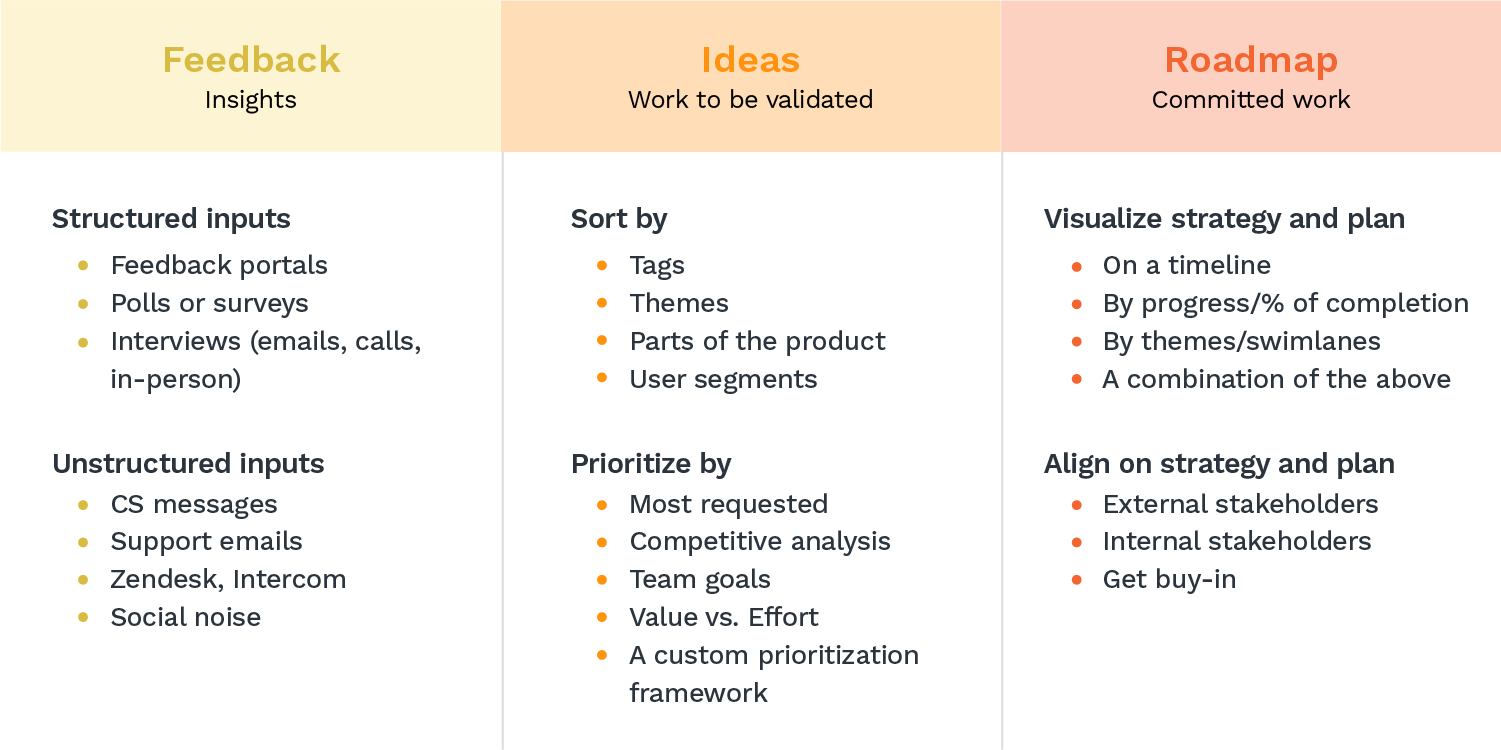Ideas can come from anywhere. But how do product managers ensure they’re working on the ones that result in customer-driven products? By tapping into the insights offered by customer feedback, of course. And how do product managers collect, organize, prioritize and align teams on these ideas? Using the right process.
Here’s a scenario you’re probably familiar with: a product manager acts as the de-facto idea management...everything: the process, the system, the tool, the strategy. She collects vital customer insights and information about the product by jumping from meeting to meeting with the teams that possess this information. She’s trying—and failing—to hold these insights using multiple spreadsheets, sticky notes, and dashboards.
She also has a backlog of ideas to manage! But it bothers her to know, deep inside, that it’s a bunch of stuff the team will never build because the priorities are always changing in her highly competitive industry. She’s also in charge of leading the prioritization efforts that ensure the team is aligned and working on the most impactful features and ideas. This is hard to organize, because people are complicated, but without buy-in and alignment there’s no progress.
And that’s just a quarter of what a PM needs to be doing at all times, constantly and consistently.
But what do all the headaches in that scenario have in common? They can all be solved by having the right idea management process in place. Allow us to explain what we mean ✋
What's idea management?

Idea management is just a fancy umbrella term for the process of collecting customer feedback and consolidating it in one place, turning that feedback into sorted insights, prioritizing the ideas generated by those insights, then committing to them on the product roadmap.
Roadmunk can help you centralize feedback, prioritize ideas and build customer-driven roadmaps. Sign up for a free trial .
Customer feedback comes from different customer-facing teams working on a product. It comes from sales, support, customer success, product and even design and development. It comes in every format: as zendesk/intercom messages, emails and social noise. An idea management system acts as the repository where everyone in the organization can submit feedback and organize it in a way that’s visible and easy for the product team to find.
Ultimately, by housing that information in a dynamic knowledge base widely available to the entire product team, an idea management system facilitates building products that are customer-focused and customer-validated.
The right idea management process helps product teams see that there is
1. Tangible, validated evidence (feedback) that confirms the need for any given feature
2. A prioritized list of ideas organized by themes, segments and parts of the product
3. A set of committed roadmap items coming down the development pipeline
An idea management system includes having a strategy for involving stakeholders and customer-facing teams when it’s time to prioritize and commit to something on the roadmap. The entire product team then works together to prioritize the list of ideas generated from the customer feedback insights.

These prioritized ideas then get assessed against viability, feasibility, desirability and usability constraints and are benchmarked against business goals, the competitive market and the breadth of research the product management team has done so far (the greater context in which a product exists).
Without an organized idea management system and strategy in place—one that allows product managers to listen to all the relevant customer feedback, analyze it and collaborate with stakeholders on prioritization—product managers deal with headaches like:

- "I have too many sources of feedback and no way to gather them in one place where I can easily spot trends and common themes. Valuable input from relevant customer personas is slipping through my fingers."
- "I spend hours gathering feedback from CS, Sales and every other customer-facing team and not enough time analyzing the feedback. I know product success is proportional to the time spent listening to customers but I have too many resource constraints and I can’t prioritize it."
- "I don’t feel like I’m making enough evidence-based decisions or that I have a deep understanding of the segments I should be listening to."
- "I don’t have a flexible portal—or backlog—that facilitates planning initiatives that can change. We’re agile and/or our product exists in a dynamic market that’s always changing. An idea management strategy that doesn’t take that into account, coupled with the high context switching required to process feedback, can cause burnout."
If product teams don’t have a plan for overcoming these problems, then how can they ensure they’re building products based on information that’s grounded in real user needs?
With the right idea management, product managers instead feel confident that they’re achieving a few things:

- "I have a consolidated space for visualizing all the feedback, seeing who it came from (company type & size, job title) and the segment(s) the user belongs to."
- "I can use this information to follow up with interviews, problem exploration questions, and just to close the feedback loop if what they requested becomes a feature."
- "I can collaborate with the rest of the organization on voting, prioritizing, and submitting feedback so I’m not the only point of contact for those things."
- "I have a validated, prioritized view into the needs of my customers."
Let’s get into the activities and deliverables that make up idea management.
Idea management: Capturing, prioritizing, planning
Ideally, a strategic idea management process helps product managers succeed at capturing, prioritizing and planning the right ideas.
With the right idea management process in place, product managers can stop feeling as if crucial insights are being lost in an untamable sea of customer feedback. It also gives entire teams empowerment and visibility into how and why ideas are being prioritized.
Let’s dive into those three product management activities that fall under the idea management umbrella.
[PODCAST] Dive into the tactics Rose Yao used to collect data at Google Maps Platform when launching and improving on features.
Capturing: Where do ideas come from?

When product managers enter the space of product planning, they come into it with a deep, empathetic understanding of the users, the market and the ecosystem the product exists in.
What some call the product manager’s instinct (their ability to make good decisions for the direction of the product) is actually a combination of hyper-niche knowledge: user research, market and competitive research, and business research.
WIthout all that context, customers don’t know the product the way a product manager does. But customers still possess a unique type of vital knowledge that can only come from their experiences with the product. And in some companies, like in places where product managers can’t even dogfood the tools they build, this feedback is indispensable to the long-term health of the product.
With Roadmunk, teams can submit customer feedback to a centralized inbox using a handy Chrome extension. Customer-facing teams can submit feedback to an inbox, which can be tagged according to the product component or feature it applies to.
Types of customer feedback
Customer feedback, within the context of idea management, comes from two types of sources: structured and unstructured feedback.
Structured feedback is the kind that requires planning, having a hypothesis, and asking intentional questions that dive into a specific part of product usage and user behaviour. It’s more strategic than the unstructured kind because it requires intentionally approaching specific segments, personas or types of customers to get their specific feedback.
These are your...
- Surveys
- Polls
- Feedback portals and forms
- Interviews (via email, phone and in-person)
Unstructured feedback is the unprompted, unrequested kind gathered by everyone on the team who works in a customer-facing capacity. This feedback can fall under a spectrum that goes from complaints about the current product all the way to feature requests and suggestions. It can come from anyone, so PMs are more discerning with this type of feedback.
This is the type of feedback that comes in via...
- Support emails
- Zendesk/Intercom messages
- Social noise and forums
This type of feedback is more manageable if you have a tool like Roadmunk in place to help you funnel all of it into one organized platform.
The listening bit in idea management involves more than just collecting all the feedback that exists and centralizing it in one place. It also requires one of the most pivotal skills in a product manager’s toolkit: knowing what problems and needs are worth solving and which ones aren't.
Product success is relative to the amount of time a PM spends understanding that bigger research context that requires a lot of information originating in hundreds of different places.
Questions to ask about the feedback you receive
All feedback is important, but not all feedback should be treated equally. Feedback is only good if it comes with the necessary context needed to decide if it’s something to act on or something to put in the backlog. That’s why it’s good to ask these questions about every piece of feedback as it comes in through the pipeline:
- What customer segment does the user giving the feedback belong to?
- Why are they reaching out? What are they hoping to achieve if we build what they request?
- Are they using our product the right way? Is the problem something that can be solved using an existing feature or tool?
- How much of a headache (time, effort, cost) is this problem for this user?
Finally, on the margin between organizing feedback into accessible categories and prioritizing it, product managers have to ask themselves three table stakes questions about each potential idea before it even gets quantified with a prioritization method:
- Is it viable? Will we get a good ROI on this idea? Will it contribute to the long-term growth of the product and the business?
- Is it feasible? Do we have the technical and people resources to build this idea?
- Is it desirable? Does this solve the right user-validated problem/want/need?
The next step in the idea management process is team prioritization, stakeholder alignment and buy-in.
Prioritizing: How can I organize and prioritize product ideas?
Here's a recipe for disaster: prioritizing which ideas get turned into a committed roadmap initiative just by number of requests and votes. If it was that easy, prioritization wouldn’t be such a thorn on a PM’s side.
Customer feedback can come from irrelevant user segments or be rooted in a problem that can be solved with solutions already offered by the existing product. Without a fair assessment of the internal and external factors that determine whether an idea will succeed, there are just too many unnecessary risks.
What if an idea is a time sink and a resource drain that yields little to no impact on the growth of the product? The question alone should send shudders down the spines of product professionals both new and seasoned. Can product managers do anything to ensure that those risks, constraints and potential opportunities are accounted for, quantified and widely agreed-upon? If so, how?
Here at Roadmunk, we’re fans of value vs. effort and RICE. So much that we offer them as prioritization frameworks in our idea management suite.
But if you want a quick pen-and-paper/whiteboard method, a value vs. effort matrix can be a lean way to go about it.
Value vs Effort matrix
A 2x2 matrix helps product teams quantify and visualize the resources needed to realize an idea (effort, cost, risk) and how the idea will affect business goals (usually labelled ‘value’ or ‘impact’).
Calculating effort is easy enough: just add the number of work hours per person that it will take to build the idea. Value, also known as impact or complexity, is a bit trickier. To calculate the nebulous (and speculative) value of an idea, have your team match ideas with the specific metrics and goals they will push forward. Then assign a numerical value on how valuable the idea is towards fulfilling those business goals.
Here’s what it looks like as a graph:

And here’s what each quadrant tells you:
- High value, low effort: These are the quick wins, the no-brainers, the low-hanging fruit. These are the ideas that don’t require tons of development effort, time, or money. They’re risk-averse, cheap solutions that are relatively easy on the technical side.
- High value, high effort: These are the ideas that need a strategic approach. Your team will definitely work on implementing these ideas at some point in the future, they just need to be planned out more carefully.
- Low value, low effort: These are the “maybes”, the “will get to it later when the scope opens up a bit more” ideas. They’re not essential to the success of the product, but they’d have a noticeable impact.
- Low value, high effort: These are the ideas you can afford to pass up. They’re not worth doing at the time of the assessment, and they’re not likely to become a priority for a while.
A prioritization matrix isn’t the only source of truth when it comes to deciding which ideas get turned into initiatives on the roadmap. But it’s a good way to get a baseline or benchmark that everyone can agree on.
Planning and executing: when is an idea ready to go on the roadmap?
Once you have the ideas your team is ready to commit to, it’s time to make sure everyone’s on the same page in terms of buy-in and alignment.
After an idea has been assessed against all the relevant factors that influence the direction of a product (competitive analysis, internal goals, value vs. effort), it’s time to plot it along a roadmap.

Sticking an idea on the roadmap doesn’t mean the work is done. It’s merely the beginning-middle bit of the product planning process. After stating the intention to work on the idea at some point in the future, product roadmaps must be flexible and able to adapt to the ever-changing landscape of software development (especially within agile teams).
Not to mention, product plans and strategies can change according to the discoveries found through user research and testing (prototypes, mockups, UX tests) and the competitive ecosystem the product exists in.
That’s why we define product roadmaps as statements of intent rather than literal, set-in-stone maps.
What's the TL;DR of idea management?
Idea management feels like a massive amount of work that encompasses literally every aspect of a product manager’s job. But it’s really just a term for the process of going from a piece of relevant feedback to a prioritized, committed item on the roadmap.

Here's a recap of the main deliverables and moving parts that make up each part of idea management:

Having a centralized and collaborative idea management process with the right tooling doesn’t ensure that your team will always build the right thing, but it’s a success factor that can make or break a product.
If one of your priorities is to build customer-driven products but you don’t have time to gather, process and organize customer feedback in an organized way, it’s time to re-evaluate your ideation process.
Ready to start building customer-driven roadmaps? Sign up and try our ready-to-use templates.

